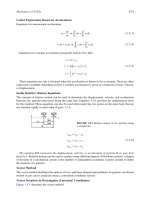Traffic Engineering Handbook, 7th Edition
Bạn đang xem bản rút gọn của tài liệu. Xem và tải ngay bản đầy đủ của tài liệu tại đây (30.37 MB, 1,104 trang )
TableofContents
TitlePage
Copyright
Preface
EditorialPreface
Acknowledgments
Chapter1:IntroductiontotheTrafficEngineeringHandbookandItsRoleinEvolving
Practice
I.Background
II.TheVisionforThisEdition
III.OrganizationoftheHandbook
References
Chapter2:ProbabilityandStatisticalAnalysesTechniquesforTrafficEngineering
PerformanceMeasurement
I.Introduction
II.DescriptiveStatistics
III.Probability
IV.ProbabilityDistributions
V.ConfidenceIntervalsandHypothesisTesting
VI.RegressionModeling
VII.FinancialAnalysisandEngineeringEconomics
VIII.FundamentalConceptsinEngineeringEconomics
IX.Before-and-AfterStudies
References
Chapter3:RoadUsers
I.Introduction
II.Basics
III.TypesofRoadUsers
IV.PROFESSIONALPRACTICE
V.CaseStudies
VI.EMERGINGTRENDS
VII.FurtherInformation
References
Chapter4:TrafficEngineeringStudies
I.Introduction
II.BasicPrinciplesandGuidanceResource
III.ProfessionalPractice:CommonTrafficStudyProcedures
IV.EmergingTrends
References
Chapter5:LevelofServiceConceptsinMultimodalEnvironments
I.Introduction
II.Basics:ConceptualFoundationsofLevelofService
III.ApproachestoLevelofServiceandPerformanceMeasuresforDifferentModes
IV.MultimodalEnvironments
V.TypesofMultimodalEnvironments
VI.MultimodalLevelofServiceAnalysis
VII.ChallengestoUsingMMLOS
VIII.CaseStudies
IX.EmergingTrends
References
Chapter6:ForecastingTravelDemand
I.IntroductionandApproach
II.BasicPrinciples
III.ProfessionalPractice
IV.CaseStudies
V.EmergingTrends
References
Chapter7:TrafficFlowCharacteristicsforUninterrupted-FlowFacilities
I.Introduction:CharacterizingTrafficFlowforAnalysis
II.Basics:TrafficFlowCharacteristicsforPerformanceMeasurement
III.ProfessionalPractice:MeasuringTrafficCharacteristics
IV.TrafficFlowRelationshipsforUninterruptedFlow
V.TrafficShockWaves
VI.MeasuringTrafficCharacteristicsatBottlenecks
VII.QualityofServiceonUninterrupted-FlowFacilities
VIII.CaseStudies
References
Chapter8:DesignandOperationsofRoadSegmentsandInterchangesinRuralAreas
I.BasicPrinciplesandReferenceSources
II.ProfessionalPractice
III.CaseStudies
IV.EmergingTrends
References
Chapter9:Planning,Design,andOperationsofRoadSegmentsandInterchangesinUrban
Areas
I.Introduction
II.BasicPrinciples
III.ProfessionalPractice
IV.CaseStudies
V.EmergingTrends
References
Chapter10:DesignandControlforInterruptedTrafficFlowthroughIntersections
I.BasicPrinciples
II.ProfessionalPractice
III.CaseStudies
IV.EmergingTrends
V.Conclusions
References
FurtherInformation
Chapter11:DesignandOperationofCompleteStreetsandIntersections
I.BasicPrinciples
F.ProfessionalPractice
III.CaseStudies
IV.EmergingTrends
References
Chapter12:AccessManagement
I.Introduction
II.BasicPrinciples
III.BenefitsofAccessManagement
IV.ProfessionalPractice
V.CaseStudies
VI.EmergingTrends
VII.Conclusion
References
Chapter13:Parking
I.Introduction
II.BasicPrinciplesandFundamentals
III.ProfessionalPractice
IV.CaseStudies
V.EmergingTrends
References
Chapter14:TrafficCalming
I.BasicPrinciplesandReferenceSources
II.ProfessionalPractice
III.Toolbox
IV.CaseStudies
V.EmergingTrends
References
FurtherInformation
Chapter15:WorkZoneMaintenanceofTrafficandConstructionStaging
I.BasicPrinciples
II.ProfessionalPractice
III.ImplementingtheTransportationManagementPlan
IV.OtherPracticeIssues
V.CaseStudies
VI.EmergingTrends
References
Chapter16:TrafficManagementforPlanned,Unplanned,andEmergencyEvents
I.BasicPrinciples
II.ProfessionalPractice
III.CurrentPractice
IV.CommonPitfalls
V.CaseStudies
VI.EmergingTrends
References
Index
EndUserLicenseAgreement
ListofIllustrations
Chapter2:ProbabilityandStatisticalAnalysesTechniquesforTrafficEngineering
PerformanceMeasurement
Figure2.1HistogramofSpotSpeeds
Figure2.2SamplePercentile(orQuartile)SpeedValues(mph)
Figure2.3RelationshipsinProbabilityandInferentialStatistics
Figure2.4SampleTreeDiagram
Figure2.5NormalDistribution
Figure2.6AreaunderaNormalDistribution
Figure2.7SimplificationofCashFlowDiagram
Figure2.8StandardCashFlow
Figure2.9MaintenanceExpensesCashFlowDiagramwithGandAFactors
Figure2.10CashFlowDiagramwithGFactor
Figure2.11CashFlowDiagramwithAFactor
Figure2.12IncrementalB/CAnalysisProcess
Figure2.13BreakevenAnalysis
Figure2.14DecisionTree
Figure2.15CashFlowDiagram
Figure2.16BreakevenAnalysis
Figure2.17RegressiontotheMeanandBias
Chapter3:RoadUsers
Figure3.1TheRelationshipbetweenViewingDistanceandImageSize
Figure3.2UsefulFieldofView
Figure3.3PercentofFixationTimebyLocationasaFunctionofTrialsforOpen
Driving(OneSubject)
Figure3.4PercentofFixationTimebyLocationasaFunctionofTrialsforCar
Following(OneSubject)
Figure3.5FromBieLo,&Wong(2008)
Figure3.6PerceivedRiskofanAccidentandSpeed
Figure3.7ExampleofBadPracticeinDelineationofRoadPath:View740ft(225m)
SouthofAreaofImpact
Figure3.8SignPlacementConsiderations
Figure3.9LateralPeripheralPavementMarkings
Chapter4:TrafficEngineeringStudies
Figure4.1UrbanIntersection
Figure4.2DepartureSightTrianglesforStop-ControlledIntersection(AASHTO,
2011)
Figure4.3PedestrianActions—CrossingataCrosswalkinForegroundandMidblock
intheBackground
Figure4.4Regression-to-the-MeanandRegression-to-the-MeanBias
Chapter5:LevelofServiceConceptsinMultimodalEnvironments
Figure5.1SubstitutingLivabilityforVehicularService
Figure5.2AppropriateDomainforMMLOSAnalysis
Figure5.3athrough5.3dAutoLOS
Chapter6:ForecastingTravelDemand
Figure6.1Four-StepTrip-BasedTravelDemandModelingProcess
Figure6.2ConceptualModeChoice“Nest”
Figure6.3HierarchyofModels
Chapter7:TrafficFlowCharacteristicsforUninterrupted-FlowFacilities
Figure7.1FHWAVehicleClassificationScheme
Figure7.25-MinuteVolumeVariationandRelationtoFlowRates
Figure7.3HourlyVolumebyTimeofDayandDayofWeek
Figure7.4VolumeVariationbyDayofWeek
Figure7.5VariationsinDailyTrafficasPercentageofWeeklyTraffic
Figure7.6VariationofHourlyVolumesasPercentageofDailyVolumeforRural
Routes
Figure7.7VolumeVariationbyMonthoftheYear
Figure7.82013AADTMapforSouthernBrazosCounty,Texas
Figure7.9IllustrationofFourMethodsforMeasuringTrafficCharacteristics
Figure7.10Flow-Speed-DensityRelationshipsfortheGreenshieldsModel
Figure7.14Speed–DensityRelationshipforEdieHypothesis
Figure7.11GreenshieldsSpeed–DensityRelationshipPlottedAgainstActualSpeed
andDensityData
Figure7.20VariationofVolume,Speed,andOccupancyOver24Hours
Figure7.21ShockWaveatFreewayIncident
Figure7.22ImpactofLocationonCapacity
Figure7.23EffectofLocationonMeasurementandAnalysis
Figure7.24Space–TimeIllustrationofExampleShockWaveAnalysis
Figure7.25HCMLOSforBasicFreewaySegments
Chapter8:DesignandOperationsofRoadSegmentsandInterchangesinRuralAreas
Figure8.1Ball-BankIndicator
Figure8.2HorizontalCurveComponents
Figure8.3ExampleSuperelevationTransitionProfile
Figure8.4VerticalCurveComponents
Figure8.5ScalingandRecordingSightDistancesonPlans
Figure8.6TypicalRuralMedians
Figure8.7ClearZoneDistanceCurve
Figure8.8CommonInterchangeForms
Figure8.9InterchangeSelectionProcessMatrix
Figure8.10GeneralTypesofRamps
Figure8.11MinimumRampSpacingGuidelines
Figure8.12RoadSafetyManagementProcess
Figure8.13CrashDiagramforaRoadwaySegment
Figure8.14TypicalRegulatorySigns
Figure8.15TypicalWarningSigns
Figure8.16TypicalGuideSigns
Figure8.17TypicalMotoristInformationSigns
Figure8.18HorizontalAlignmentWarningSigns
Figure8.19CurveWarningSignUsedWhereAdvisorySpeedIs35mphorHigher
Figure8.20ViewsofRSASite(OklahomaDOTRSA)
Figure8.21ExampleofDCMGraphicalOutputforaRoadwaySegment
Chapter9:Planning,Design,andOperationsofRoadSegmentsandInterchangesinUrban
Areas
Figure9.1ElevatedUrbanFreewaySegment
Figure9.2ConceptualDesignofaDual-DividedUrbanFreeway
Figure9.3Shared-UsePathParalleltoI-5nearOlympiaandLacey,Washington
Figure9.4DiamondInterchangeConfigurationsCommontotheUrbanContext
Figure9.5PairedRoundaboutsatDiamondInterchange
Figure9.6DivergingDiamondInterchange
Figure9.7PartialCloverleafInterchangesCommonintheUrbanContext
Figure9.8ExampleofGrade-SeparatedRamps
Figure9.9TypicalExamplesofLaneBalance
Figure9.10CommonWeavingConfigurations
Figure9.11OpenPricedDynamicShoulderLane
Figure9.12TypicalSectionofWAUS2DynamicShoulderLane
Figure9.13PeakHourTravelSpeedBefore-and-AfterShoulderOperation
Figure9.14DDIatI-494and34thAvenueSouthinBloomington,Minnesota
Figure9.15LRTBlankoutSignsatDDICrossoverIntersection—Bloomington,
Minnesota
Figure9.16LaneConfigurationsBeforeandAfterCDLanes
Figure9.17Interstate20Collector–DistributorLanes,DeKalbCounty,Georgia
Figure9.18SummaryofProjectInterchangeTypesEvaluated
Figure9.19Interstate5ATMCorridorinSeattle,Washington
Figure9.20Interstate5ATMElectronicSignBridges
Figure9.21OriginalInterchangeatI-70andPecosStreet
Figure9.22ImprovedInterchangewithRoundabouts
Figure9.23ImprovedPedestrianCrossingwithHybridBeacon
Figure9.24CloverleafofI-93andI-95inWoburn,Stoneham,andReading,
Massachusetts
Figure9.25RenderingofAlternativeHS-OSforImprovedI-93/I-95Interchange
Figure9.26I-95inSouthFloridawith95ExpressLanes
Figure9.27TravelSpeedProfilesforExpressLaneBuildandNo-BuildAlternatives
Chapter10:DesignandControlforInterruptedTrafficFlowthroughIntersections
Figure10.1IntersectionPhysicalandFunctionalAreas(TRB,2003)
Figure10.2ExampleofRoundaboutfromCityofLeeSummit,Missouri
Figure10.3FunctionalIntersectionDistances
Figure10.4ParallelandTaperedOffsetTurnLanes
Figure10.5BicycleBoxes
Figure10.6Two-StageTurnQueueBoxesinPortland,Oregon
Figure10.7IntersectionRealignmentAlternatives
Figure10.8LaneandMovementGroupDesignation
Figure10.9RingBarrierDiagram
Figure10.10Lead–LeadLeft-TurnPhasingRingBarrierDiagram
Figure10.11Lag–LagLeft-TurnPhasingRingBarrierDiagram
Figure10.12Lead–LagLeft-TurnPhasing
Figure10.13TypicalComponentsofaSignalTimingPlan'sPhases
Figure10.14DilemmaorIndecisionZone
Figure10.15SignalizedIntersectionFlowRateasaFunctionofTime
Figure10.16DeterministicQueueRepresentationatanUnsaturatedSignalized
IntersectionApproach
Figure10.17TurningMovementsatMedianU-TurnIntersections
Figure10.18ContinuousFlowIntersection
Chapter11:DesignandOperationofCompleteStreetsandIntersections
Figure11.1ModalHierarchy
Figure11.2SpeedandFocus
Figure11.3SpeedReductionMechanisms
Figure11.4FunctionalClassification
Figure11.5ArterialExamples
Figure11.6TruckCirculation
Figure11.7ProcessStages
Figure11.8SidewalkZones
Figure11.9StreetTreesandSightDistance
Figure11.10CurbRadii
Figure11.11ChannelizedRightTurn
Figure11.12LayeredNetwork
Figure11.13MainStreetinHamburg,NewYork
Figure11.14StreetscapeImprovementsinWestJefferson,NorthCarolina
Figure11.15CompleteStreetTransformationof300SouthinSaltLakeCity,Utah
Figure11.16SampleCompleteStreetsChecklist
Figure11.17SharedSpaceExample
Figure11.18TacticalUrbanismExample
Chapter12:AccessManagement
Figure12.1TripStagesinaFunctionalCirculationSystem
Figure12.2RoadwayClassificationBasedonaContinuumofFunctions
Figure12.3RoadwayClassificationBasedonSeparationofFunctions
Figure12.4UrbanArterialSpacingGuidelines
Figure12.5AccessRelationshipbetweenFunctionalCategories
Figure12.6ProgressionSpeedasaFunctionofSignalSpacingandCycleLength
Figure12.7SchematicIllustrationofIntersectionFunctionalArea
Figure12.8UpstreamFunctionalIntersectionAreawithandwithoutaTurnBay
Figure12.9VehicularConflictPoints
Figure12.10SeparatingConflictAreasReducesDriverWorkloadandtheExposureof
BicyclesandPedestrianstoPotentialCrashes
Figure12.11IllustrationoftheEffectofSpeedDifferentialbetweenTurningVehicles
andThroughTrafficonCrashPotential
Figure12.12BypassLaneataT-Intersection
Figure12.13CompositeCrashRateIndices
Figure12.14VariationinVehicleFuelConsumptionandEmissionRatesasaFunction
ofCruiseSpeed
Figure12.15HazardousPedestrianEnvironmentonBridgeportWay,UniversityPlace,
Washington,beforetheImprovement
Figure12.16SignalizedMidblockCrossingServingTransitStops.BridgeportWay,
UniversityPlace,Washington
Figure12.17BridgeportWayMultimodalCorridorAccessImprovements;Bridgeport
Way,CityofUniversityPlace,Washington
Chapter13:Parking
Figure13.1ParkletinSanFrancisco
Figure13.2PodiumParking
Figure13.3WrappedParking
Figure13.4AutomatedMechanicalParkingFacility
Figure13.5WayfindingPhases
Figure13.6CriticalWayfindingCharacteristics
Figure13.7U.S.PassengerVehicleSales—2013CalendarYear
Figure13.8SalesofVehiclesbyPCCClass
Figure13.9ParkingStallLayoutTerminology
Figure13.10AlternativeParkingLayoutsReflectingOperationalCharacteristics
Figure13.11StallandModuleDimensionLegend
Figure13.12RotationofStallforAngledParking
Figure13.13PercentofAutomobilesAppropriateforSCOStalls
Figure13.14RestripingParkingtoMoreAppropriateDimensions
Figure13.15AngledandParallelOn-StreetParking
Figure13.1630-DegreeAngledParking
Figure13.17Back-InAngledParking
Figure13.18On-StreetAngledParkingwithDedicatedParkingAisle
Figure13.19TurningBaysinTwo-WayParking
Figure13.20Long-Spanvs.Short-SpanDesign
Figure13.21TurningOn/OffSlipRampsatEndAisles
Figure13.22DifferentialSlopeatHingePoints
Figure13.23BicycleandMotorcycleParkingatLotEntry/Exit
Figure13.24BicycleCenteratTransitStation
Figure13.25PedestrianPathsinParkingFacilities
Figure13.26IdealPedestrianandVehicleSeparation
Figure13.27DedicatedPedestrianWalkway
Figure13.28CurbRampsCannotBePlacedinAccessAisle
Figure13.29AccessibleRoutefromStallstoExterior
Figure13.30AccessibleParallelParkingStallinWideSidewalks
Figure13.31InappropriateModificationtoaMUTCDSpeed-LimitSign
Figure13.32InappropriateModificationtoaMUTCDStopSign
Figure13.33CirculationRoadsataShoppingCenter
Figure13.34Long-SpanConstructionwithLEDLightFixtures
Figure13.35EffectiveandIneffectiveProtectionOptions
Figure13.36PoorVisibilityofWheelStops
Figure13.37ParkingGuidanceSignageonPublicStreet
Figure13.38MobileParkingApptoFindParking
Figure13.39ParkingGuidanceSignageatParkingStructureEntry
Figure13.40ParkingGuidanceSignageInsideParkingStructure
Figure13.41ModificationstoGradeLeveltoResolveGridlock
Figure13.42AMPFLoadingDirectlyfromStreet
Figure13.43AMPFLoadingviaOff-StreetAccessAisles
Chapter14:TrafficCalming
Figure14.1ASpeedHumpHelpingtoMakeaNeighborhoodRoadwayFriendlierto
BicyclistsinPortland,Oregon
Figure14.2AnEarlyTraffic-CalmingInstallationinBerkeley,California
Figure14.3FlowchartShowingtheStepsofaNeighborhoodTrafficCalmingPlan
DevelopmentProcess,Austin,Texas
Figure14.4ANeighborhoodMapwithIconsPlacedbyResidentCommitteeMembers
IdentifyingTheirInitialDraftPlan
Figure14.5ADiagramIllustratingMidblockChokers(BostonTransportation
Department,2013)
Figure14.6EducationalTrafficCalmingCampaignFlyerfromSanAntonio,Texas
Figure14.7LaneStripingUsedtoReducetheTravelwayWidthinLagunaHills,
California
Figure14.8SpeedFeedbackSignwithSpeed-LimitSignUsedNearaSchoolin
Murray,Utah
Figure14.9OneoftheFirstSpeedHumpsInstalledintheUnitedStatesinBrea,
California
Figure14.10SpeedLumpsinLaHabra,California
Figure14.11RaisedCrosswalkinSanDiego,California
Figure14.12TrafficCircleAlongaBicycleBoulevardinLongBeach,California
Figure14.13Bulb-OutsinSaltLakeCity,Utah
Figure14.14MedianBarrier(withThroughBicycleAccess)AlongaBicycle
BoulevardinSanLuisObispo,California
Figure14.15HalfClosure(withThroughBicycleAccess)inSacramento,California
Figure14.16ASpeedHumpRestripedtoComplywithCurrentMUTCDStriping
StandardsinBerkeley,California
Figure14.17AdvisorySigninAdvanceofMultipleTraffic-CalmingMeasuresinLa
Habra,California
Figure14.18MultipleSpeedHumpsAlongaResidentialBlockinStockton,California
Figure14.19ASignedandStripedCrosswalkwithaMedianIslandandChokersin
AspenHill,Maryland
Figure14.20ARaisedCrosswalkwithaText-BasedAdvisorySignandStamped
ConcreteinPlaceofCrosswalkStripinginSaltLakeCity,Utah
Figure14.21ARaisedCrosswalkwithaPictorialSigninPomona,California
Figure14.22LandscapingGuidancefromAustin,Texas
Figure14.23SpeedHumpwithStampedAsphalttoIntegrateintotheExisting
SurroundingsinCharleston,SouthCarolina
Chapter15:WorkZoneMaintenanceofTrafficandConstructionStaging
Figure15.1LaneShiftUsingPartofShoulderasTemporaryTrafficLane
Figure15.2FreewayLeft-LaneClosure
Figure15.3FullShoulderUsedasTemporaryTrafficLane
Figure15.4Two-WayTrafficonHalfofaNormallyDividedHighwayUsingPavement
MarkingsandChannelizers
Figure15.5Two-WayTrafficonHalfofaNormallyDividedHighwayUsingPositive
BarrierSeparation
Figure15.6DetourforClosedRoad
Figure15.7ObservedandPredictedTotal,FatalandInjury(FI),andPropertyDamage
Only(PDO)Crashesvs.TrafficDensityinMillionsofVehicleMilesofTravel
(MVMT)
Figure15.8Truck-MountedAttenuatoronShoulder
Figure15.9TemporaryInterchangeEntranceRampforMedianCrossover
Figure15.10TemporaryInterchangeExitRampforMedianCrossover
Figure15.11ThereIsNoEvidencethatHigherFinesinWorkZonesAreEffectivein
ChangingDriverBehavior
Figure15.12CanopiedPathwayforPedestrians
Chapter16:TrafficManagementforPlanned,Unplanned,andEmergencyEvents
Figure16.1IncidentScale,PublicPreparedness,andGovernment/Jurisdiction
Involvement
Figure16.2TransportationFunctionalAreaswithinNIMS
Figure16.3EmergencyPlanningCycle
Figure16.4EmergencyPreparednessCycle
Figure16.5SamplePlanEliminatingLeftTurns
Figure16.6PublicAssistedEvacuationPlanTimeline
Figure16.7SimulatedEvacueeTravelTimeImprovementsforRampClosureand
CrossingElimination
Figure16.8InterdependentSystemsforResilience
Figure16.9ResiliencePreceptsandPrinciples
ListofTables
Chapter1:IntroductiontotheTrafficEngineeringHandbookandItsRoleinEvolving
Practice
Table1.1ContentMappingfromTEH6thEdition
Chapter2:ProbabilityandStatisticalAnalysesTechniquesforTrafficEngineering
PerformanceMeasurement
Table2.1RandomSpotSpeedsonanUrbanArterial(mph)
Table2.2SpotSpeedsonanUrbanArterialinIncreasingOrder(mph)
Table2.3FrequencyDistributionforSpotSpeedData
Table2.4wo-LaneRuralLocalRoadwaySpeedData—Grouped
Table2.5
Table2.6
Table2.7
Table2.8
Table2.9
Table2.10
Table2.11
Table2.12
Table2.13
Table2.14
Table2.15
Table2.16
Table2.17
Table2.18
Table2.19
Table2.20
Table2.21
Table2.22
Table2.23
Table2.24FourBefore-and-AfterStudyTypes
Chapter4:TrafficEngineeringStudies
Table4.1ContentoftheITEManualofTransportationEngineeringStudies(MTES)
Table4.2StandardDeviationsofSpotSpeedsforSampleSizeDetermination
Chapter5:LevelofServiceConceptsinMultimodalEnvironments
Table5.1TypicalConventionalRoadClassification
Table5.2MultimodalClassificationScheme
Table5.3aComparisonofSignal-SpecificDesignEffectsontheHCM2010MMLOS
Table5.4MultimodalAlternativeSummary
Table5.5RetailSalesGrowthinPedestrianandBikeEnhancementCorridorsRelative
toControlSites
Table5.6InputstoSimplifiedMMLOSMethodology
Chapter7:TrafficFlowCharacteristicsforUninterrupted-FlowFacilities
Table7.1MacroscopicandMicroscopicDataComparison
Table7.2ExampleKFactorsbyAADT
Table7.3ExampleDirectionalDistributionValues
Table7.4TypicalDailyAdjustmentFactors
Table7.5TypicalMonthlyAdjustmentFactors
Table7.6Time-andSpace-MeanSpeedCalculations
Table7.7EquationsAssociatedwiththeGreenshieldsModel
Table7.8LevelofServiceforUninterruptedFlowFacilities
Table7.9CapacityValuesforBasicFreewaySegments
Chapter8:DesignandOperationsofRoadSegmentsandInterchangesinRuralAreas
Table8.1DesignVehicleDimensions
Table8.2PassingSightDistancesforDesignofTwo-LaneHighways
Table8.3ClearZoneAdjustmentFactorsonHorizontalCurves
Table8.4Run-off-the-RoadCrashesonaSectionofTwo-LaneRuralHighway
Table8.5Head-OnCrashesonaSectionofTwo-LaneRuralHighway
Table8.6RecommendedMinimumLetterHeightsonStreetNameSigns
Table8.7ChallengesforRuralTransportationPlanning
Table8.8SummaryofSafetyIssuesandSuggestionsOklahomaDOTRSA
Chapter10:DesignandControlforInterruptedTrafficFlowthroughIntersections
Table10.1FunctionalIntersectionDistances
Table10.2SignalTimingPolicyandStrategies
Table10.3MinimumGreenTimetoSatisfyDriverExpectations
Table10.4MinimumGreenRequirementstoSatisfyQueueClearance
Chapter11:DesignandOperationofCompleteStreetsandIntersections
Table11.1ContextZoneCharacteristics
Table11.2PedestrianFatalityRisk
Chapter12:AccessManagement
Table12.1TripStageandFunctionalRoadwayCategoryCompatibility
Table12.2ExpansionoftheBasicFunctionalRoadwayCategories
Table12.3ComparablePublicStreetClassificationsandSiteAccessandCirculation
Elements
Table12.4ExampleofSeparationofConflictPointsBasedonSightDistances
Table12.5SuggestedWarrantsforLeft-TurnLanesatAccessConnectionsonanUrban
orSuburbanArterialBasedonBenefit/CostCriteria
Table12.6SuggestedWarrantsforLeft-TurnLanesatAccessConnectionsinRural
Areas
Table12.7SuggestedSummaryofColoradoDOTDecelerationLaneWarrants
Table12.8MinimumDesignLengthofaLeft-TurnorRight-TurnLane,Excluding
QueueStorage
Table12.9SuggestedBypassLaneWarrantsforRuralTwo-LaneHighways
Table12.10GeorgiaDepartmentofTransportationWarrantsforBypassLanes
Table12.11EstimatedReductioninCrashesFollowingTurnLaneInstallationon
MajorApproaches
Table12.12AccessPointsandFree-FlowSpeed
Table12.13PercentageIncreaseinTravelTimesasSignalizedDensityIncreases
Table12.14ExcessHoursofDelayper1000SpeedChangeCyclesa
Table12.15ExcessFuelConsumptionDuetoDecelerationFollowedbyAcceleration
toInitialSpeeda
Table12.16ExcessVehicularEmissionsDuetoDecelerationFollowedby
AccelerationtoOriginalSpeeda
Table12.17Illustrationof“Minimum”and“PermittedbyVariance”ValuesforAccess
ManagementStandards
Table12.18AddressingPublicConcernsaboutMedians
Table12.19BenefitsReportedinSelectedCaseStudies
Chapter13:Parking
Table13.1CosttoOwnandOperateaNewParkingFacility
Table13.2DimensionsofPassengerVehicles
Table13.3StallandModuleDimensions
Table13.4Single-LoadedOn-StreetParking
Table13.5ParkingEquipmentServiceRates
Table13.6RecommendedMaximumWalkingDistances
Table13.7AccessibleSpacesforOn-StreetParking
Table13.8RecommendedMaximumsandMinimumsforCoveredParkingLighting
Table13.9ProjectedPEVSalesandPercentageofLightVehiclesonRoad
Table13.10RecommendedStallsforEVCSsinWorkplaceandVisitorParking
Facilities
Chapter15:WorkZoneMaintenanceofTrafficandConstructionStaging
Table15.1SummaryofWorkZoneStrategies
Table15.2GeneralGuidelinesforVehicleCapacitythroughWorkZonesinVehicles
perHour(VPH)
Table15.3ObservedCapacitiesforTypicalFreewayWorkZonesinVehiclesperHour
(VPH)
Table15.4CapacityofLong-TermWorkZonesinVehiclesperLaneperHour(VPH)
(veh/h/ln)
Table15.5EstimatedCapacityofaSharedRight-of-WayWorkZoneStrategy(TwoWay,One-LaneOperation)inVehiclesperHour(VPH)
Table15.6IndexofChangeComparisonswithandwithoutTemporaryLaneClosures
duringPeriodsofWorkActivity
Table15.7MinimumRadiiforWorkZoneHorizontalCurvesRetainingNormalCrown
Cross-Slopes
Table15.8TaperLengthGuidelinesforWorkZones
Table15.9SuggestedOne-WayTraveledWayMinimumWidths
Table15.10ExampleofClearZoneWidthsforWorkZones
Table15.11PotentialTreatmentofRoadsideHazardsinWorkZones
Table15.12CrashPatternIdentificationandPotentialTrafficControlPlanChanges
Chapter16:TrafficManagementforPlanned,Unplanned,andEmergencyEvents
Table16.1QuickStartReferenceSummarytoGettingStartedinthe“UnusualEvents”
World
Table16.2QuickStartSuggestedActionsSummarytoGettingStartedinthe“Unusual
Events”World
Table16.3ESFsandTypicalTransportationInteractions
Table16.4TIMProgramKeyElements
Table16.5TIMPerformanceMeasuresFocusStates'Initiatives
Table16.6ExampleHazardsThatCanImpacttheTransportationSystem
Table16.7ExampleEventTypesandCharacteristicsandTheirImpactson
TransportationSystems
Table16.8TransportationResourcesintheMajorNIMSFunctionalCategories
Table16.9TransportationOperationalStrategies
Table16.10InclusiveTransportationandOutreachforPeoplewithAccessand
FunctionalNeeds
TRAFFICENGINEERINGHANDBOOK
SEVENTHEDITION
InstituteofTransportationEngineers
AnuragPande,Ph.D.
BrianWolshon,Ph.D.,P.E.,PTOE
Co-editors
Coverimage:BostonCompleteStreetsGuidelines,BostonTransportationDepartment;DunsmuirSeparatedBikeLane©Paul
Krueger
Coverdesign:Wiley
Thisbookisprintedonacid-freepaper.∞
Copyright©2016byJohnWiley&Sons,Inc.Allrightsreserved.
PublishedbyJohnWiley&Sons,Inc.,Hoboken,NewJersey.
PublishedsimultaneouslyinCanada.
Nopartofthispublicationmaybereproduced,storedinaretrievalsystem,ortransmittedinanyformorbyanymeans,
electronic,mechanical,photocopying,recording,scanning,orotherwise,exceptaspermittedunderSection107or108ofthe
1976UnitedStatesCopyrightAct,withouteitherthepriorwrittenpermissionofthePublisher,orauthorizationthroughpayment
oftheappropriateper-copyfeetotheCopyrightClearanceCenter,222RosewoodDrive,Danvers,MA01923,(978)750-8400,
fax(978)646-8600,oronthewebatwww.copyright.com.RequeststothePublisherforpermissionshouldbeaddressedtothe
PermissionsDepartment,JohnWiley&Sons,Inc.,111RiverStreet,Hoboken,NJ07030,(201)748-6011,fax(201)748-6008,or
onlineatwww.wiley.com/go/permissions.
LimitofLiability/DisclaimerofWarranty:Whilethepublisherandauthorhaveusedtheirbesteffortsinpreparingthisbook,they
makenorepresentationsorwarrantieswiththerespecttotheaccuracyorcompletenessofthecontentsofthisbookand
specificallydisclaimanyimpliedwarrantiesofmerchantabilityorfitnessforaparticularpurpose.Nowarrantymaybecreated
orextendedbysalesrepresentativesorwrittensalesmaterials.Theadviceandstrategiescontainedhereinmaynotbesuitable
foryoursituation.Youshouldconsultwithaprofessionalwhereappropriate.Neitherthepublishernortheauthorshallbeliable
fordamagesarisingherefrom.
Forgeneralinformationaboutourotherproductsandservices,pleasecontactourCustomerCareDepartmentwithintheUnited
Statesat(800)762-2974,outsidetheUnitedStatesat(317)572-3993orfax(317)572-4002.
Wileypublishesinavarietyofprintandelectronicformatsandbyprint-on-demand.Somematerialincludedwithstandardprint
versionsofthisbookmaynotbeincludedine-booksorinprint-on-demand.IfthisbookreferstomediasuchasaCDorDVD
thatisnotincludedintheversionyoupurchased,youmaydownloadthismaterialat.Formore
informationaboutWileyproducts,visitwww.wiley.com.
LibraryofCongressCataloging-in-PublicationDataisavailable:
ISBN978-1-118-76230-1(hardback)
978-1-118-76228-8(epdf)
978-1-118-76226-4(epub)
TheInstituteofTransportationEngineers,Traffic
EngineeringHandbook,7thEdition
EditorialPreface
Asthetransportationprofessioncontinuestobroadeninscopeasissuesemergeand
technologiesadvance,theInstituteofTransportationEngineershassoughttokeeppacethrough
theevolutionoftheTrafficEngineeringHandbook(TEH).Thecontentofthislatestedition
reflectsupdatestothemostprominentsourcesoftransportationpractice,includingthe
HighwayCapacityManual(HCM),ManualonUniformTrafficControlDevices(MUTCD),
APolicyonGeometricDesignofHighwaysandStreets(theGreenBook),HighwaySafety
Manual(HSM),andmanyothers.ThisversionoftheHandbookalsomarksasignificant
departurefromallpriorversionsofthispublication.
Beyondthestandardupdatestoreflectevolvingchangesinpractice,thisneweditionofthe
Handbookalsoreflectstheshiftingphilosophyoftrafficengineeringpracticeinwhich
transportationprofessionalsnolongerserveasmerelyplanners,designers,andoperatorsof
transportationsystems.Rather,theyareintegralcomponentsofmorecomprehensivesocietal
rolesofcommunitybuilders,influencersofsocialandeconomicchange,andinvestorsof
publicresources.
Justastransportationsystemsmustbeadaptedtomeetthechangingexpectationsandneedsof
usersandincreasingcostsandthreatstotheenvironment,theTrafficEngineeringHandbook
cannotbestatic.Inthisseventhedition,thehandbookreflectsanefforttoreducetraditional
modalstove-pipingandpromoteamoreinclusiveapproachtotheplanning,design,and
operationoftransportationsystems.Thegoalofthisshiftistoservetheneedsofallusersand
designcontext-sensitivetransportationfacilities,allwithaneyetowarddevelopingmore
integrated,sustainable,andresilienttransportationsolutionstoaddressmodernproblemsand
needs.
Theexpectationisforthiseditiontoequiptrafficengineersforthekeyrolesthattheywillplay
intheevolutionofcommunitiesintohubsofeconomicandsocialactivity.Thestreetsofthe
twenty-firstcenturymustmeetthecomplexneedsofsocietyinasafe,efficient,andcosteffectivemanner.TheorganizationofthisHandbookisreflectiveofthiscomplexitythrougha
functionallydrivenmultimodalapproachtocontentcategorization.Inthedevelopmentofthis
Handbook,theeditors,alongwithITEstaffandteamsofpracticingprofessionalsthroughout
NorthAmerica,haveworkedtointegratetheneedsofallmodesandalltransportationsystem
usersthroughaholisticapproachratherthanjustanafterthought.Wehopethatreaderswill
alsorecognize,appreciate,andbenefitfromthesechanges.
AnuragPande,Ph.D.andBrianWolshon,Ph.D.,P.E.,PTOE
Editors
Acknowledgments
ManyindividualscontributedtothisseventheditionoftheTrafficEngineeringHandbook,
includingtheauthors,advisorypanelmembers,reviewers,LeadershipITE(Classof2014),
andITEstaff.Manythanksforalloftheirefforts.
Theadvisorypanelwascomprisedofadiversegroupoftransportationprofessionalswith
recognizedexpertiseandactiveinvolvementintrafficengineeringissuesandpractices.The
panelmembers,listedbelow,workedwithITEstaffandthehandbook'sco-editors,inthe
developmentofthescopeofworkandindefininganewapproachforthishandbook.These
individualsservedasmentorstoeachofthechapterauthorsastheydevelopedthetechnical
contentfortheirchapters.Theyalsoparticipatedinaseriesofcriticalreviewsprovidingkey
feedbackatvariousstagesinthedevelopmentprocess.
JamesCopeland
JoannaKervin
JohnLaPlante
KeithHines
PeterKoonce
Richard(Rick)Werts
SteveBrown
ThomasHicks
TimothyHaagsma
ZakiMustafa
Thefollowingsubject-matterexpertsservedasvolunteerreviewersofthedrafthandbook
chapters:
AlanHampshire
AlbertLetzkus
AngeloRao
ArunBhowmick
BartThrasher
BenPowell
BorgChan
BradStrader









